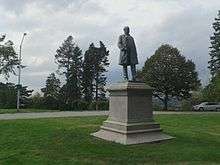Western Promenade
The Western Promenade is a historic promenade, an 18.1-acre (7.3 ha) public park and recreation area in the West End neighborhood of Portland, Maine. Developed between 1836 and the early 20th century, it is one Portland's oldest preserved spaces, with landscaping by the Olmsted Brothers, who included it in their master plan for the city's parks. The promenade was listed on the National Register of Historic Places in 1989.[1]
Western Promenade | |
 A postcard of the Western Promenade circa 1908 | |
  | |
| Location | Roughly Western Promenade from Maine Medical Center to Valley St., Portland, Maine |
|---|---|
| Coordinates | 43°38′48″N 70°16′32″W |
| Area | 18.1 acres (7.3 ha) |
| Built | 1836 |
| Architect | Goodwin, William; Olmsted Brothers |
| NRHP reference No. | 89001710[1] |
| Added to NRHP | October 16, 1989 |
Description and history

The Western Promenade occupies land overlooking a bluff on the west side of the Portland peninsula. It is bounded on the north by the Maine Medical Center complex, the east by the Western Cemetery and a historic 19th-century residential neighborhood (listed on the National Register as the Western Promenade Historic District), and the west by Valley Street. The park is now over 18 acres (7.3 ha) in size, and basically linear in shape. The park provides views to the west which include the White Mountains of New Hampshire. The steep slope of the bluff is wooded, except for a section near West Street where a trail is cut down to Valley Street. The network of trails on the bluff is essentially that laid out by John C. Olmsted in 1905.[3]
The city began acquiring land on the peninsula's western bluff as early as 1836, since it had long been recognized for its scenery and views, and there was public pressure for increased open space on the increasingly urbanized peninsula. At some point a tree-lined drive was built along the bluff. Beginning in the late 1870s, city engineer William Goodwin championed efforts to further improve the park. In the 1890s and 1900s, Mayor James Phinney Baxter engineered the expansion of the park to its present dimensions, and hired the Olmsted Brothers to oversee a landscaping plan for the park, and to develop a master plan for the city's parks. Design work on the Western Promenade is credited to John C. Olmsted and Henry Vincent Hubbard, then an apprentice with the Olmsted firm.[3]
Gallery
 The Western Promenade and a statue of Thomas Brackett Reed
The Western Promenade and a statue of Thomas Brackett Reed
References
- "National Register Information System". National Register of Historic Places. National Park Service. July 9, 2010.
- "THIS PLACE MATTERS: THE WEST MANSION" - Portland Landmarks
- "NRHP nomination for Western Promenade". National Park Service. Retrieved 2016-04-06.